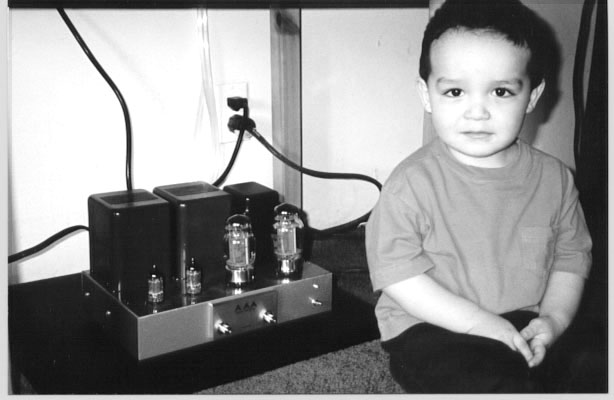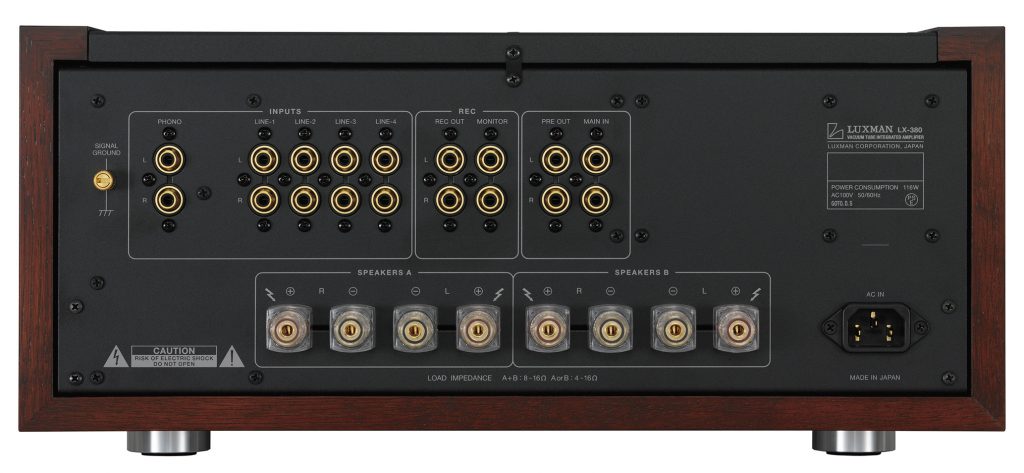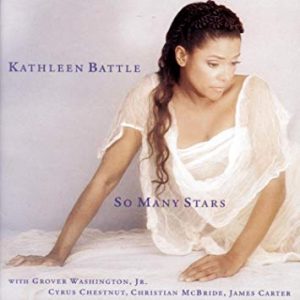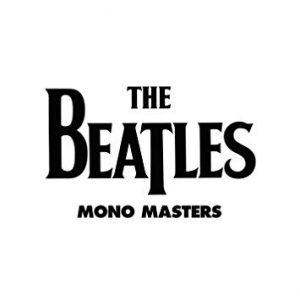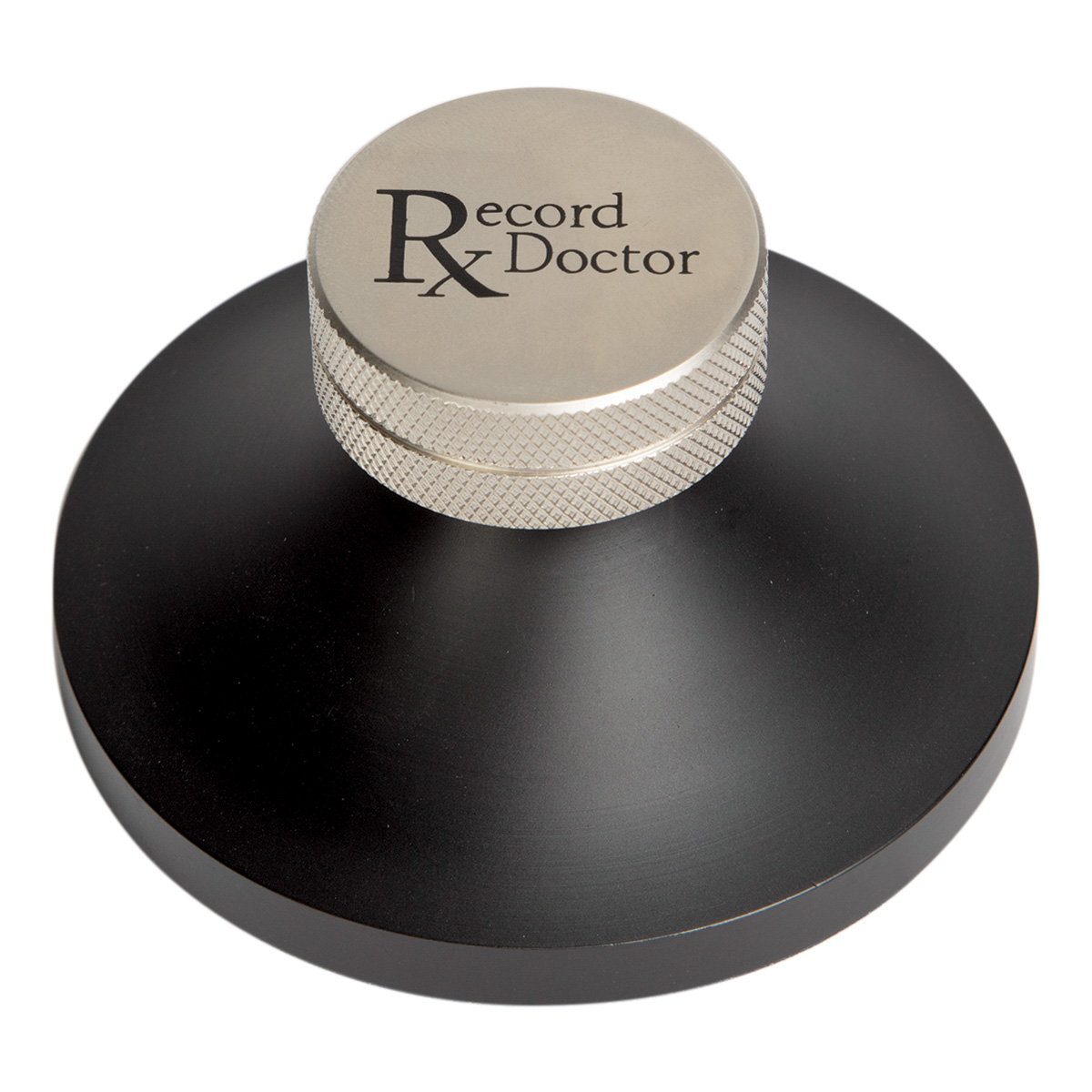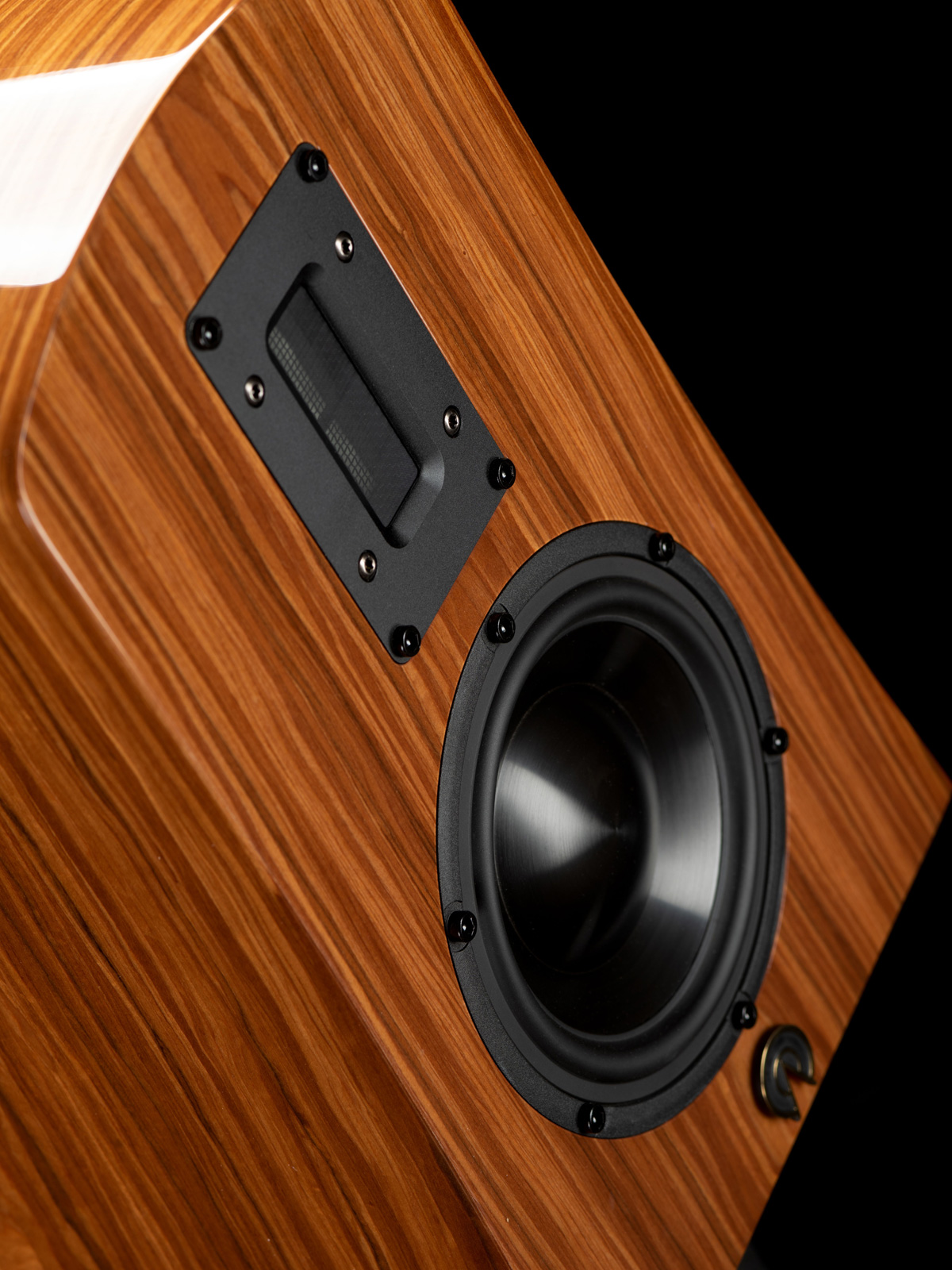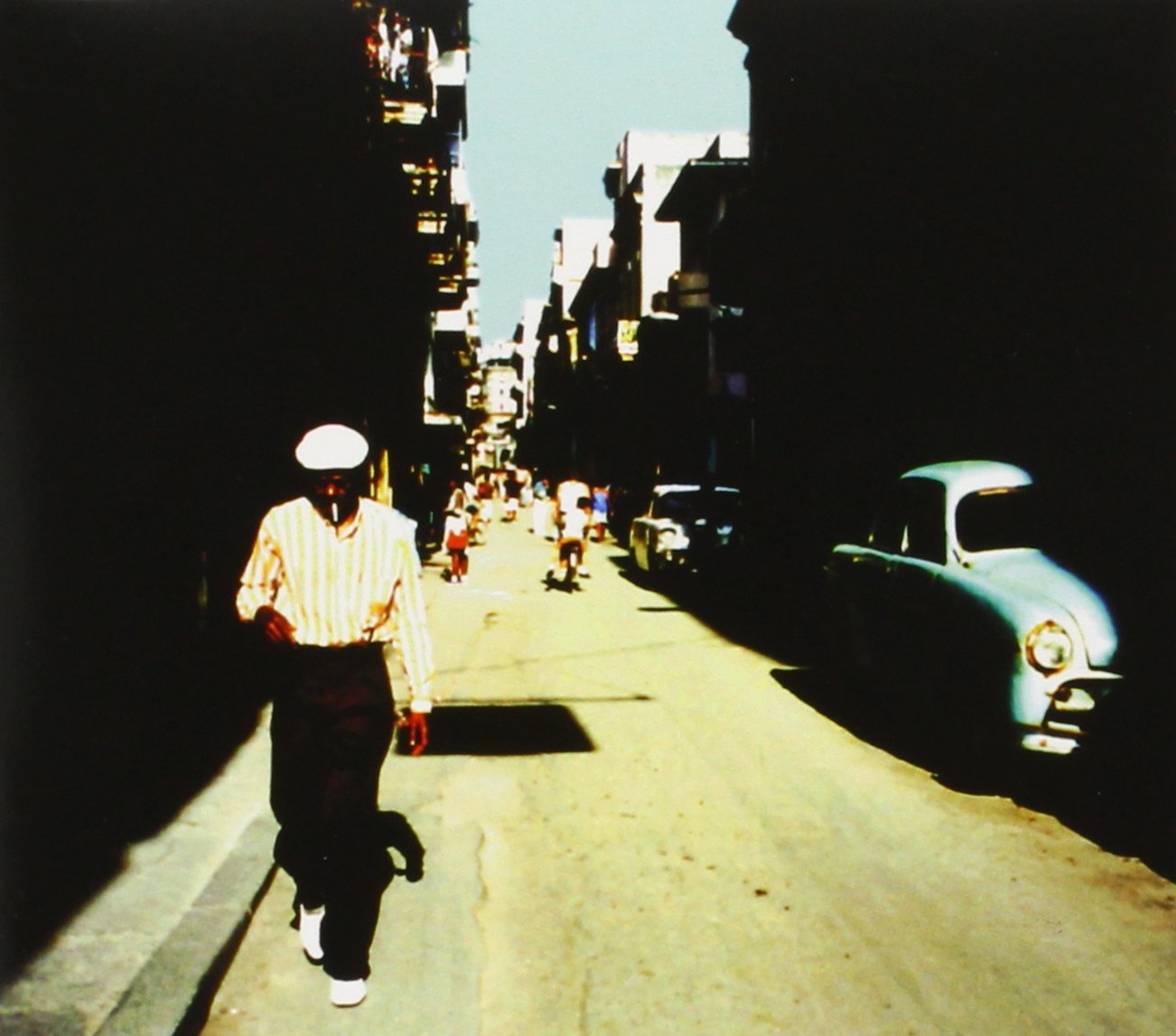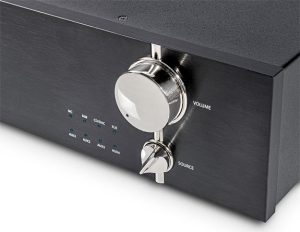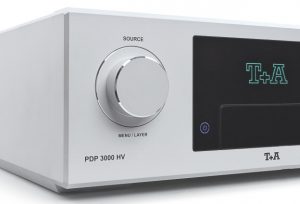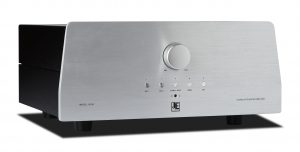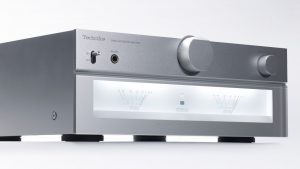The image above is presented as proof of my credentials for reviewing vacuum tube integrated amplifiers. The photo of my younger son was taken two decades ago sitting next to the Air Tight Acoustic Masterpiece M-101 integrated amplifier (audioMusings Issue 6, 1998 HERE). The infant is now a grown man and moved on to pursue his fortune in the world. I wish him peace and happiness.
Luxman LX-380
Luxman has been producing highly regarded audio components in Japan since 1925. The roots of the LX-380 go back to 1964 with the SQ-38 followed by the 70th anniversary SQ-38s in 1995. Both units featured beautiful wooden cases and brushed aluminum fronts. As testament of its heritage, the LX-380 is an exclusively analogue device. Only the Luxman Electronic Controlled Ultimate Attenuator (LECUA), a precision microprocessor controlled volume, anchors the LX-380 in this century. The 39 lbs. LX-380 features three 12AU7 drivers and four 6L6GC power tubes in push pull configuration. Both tubes are commonly used in musical instrument amplifiers and will certainly be in production for decades. Power is rated as 20W into 6 Ohms, 18W into 8 Ohms, and 14W into the 4 Ohms Tekton Design Impact Monitors.
The classic looking front panel hosts various knobs, paddle switches, and a ¼ inch headphone jack. I never unwrapped the remote control such was my pleasure when adjusting the silky smooth volume control. In fact, everything about the LX-380 was a sensory delight. Rather than being shrouded in plastic when unboxed, the LX-380 was wrapped in gossamer like rice paper within a soft white cloth bag. I found the subtle aroma of finely finished wood, hot glass, and electrical traces intoxicating while listening.
Digital duty was handled by a Heed Dactilus DAC and QPSU power supply connected via USB to the AURALiC Aries streaming network-bridge. Also in play, was my Pioneer PLX 1000 turntable with LP Gear The Vessel A3SV moving magnet cartridge.
I settled into a comfortable routine during the month that the Luxman was in my system. After the heavy traffic drive home from work, I would turn on the LX-380 and iPad used for accessing Tidal and music files. In the approximately one minute it took both units to boot up, my shoes were off and I was relaxing on the couch. A soft click and yellow light signals the LX-380 is ready to play.
Next begins the drinking game. Every time you read the words life like, harmonious, holographic, beautiful, presence, depth, or spacious, take just a sip, preferably of super smooth Kikori Japanese rice whiskey. By the end of this review you might feel as happy as I was while listening to the miraculous LX-380. Simply stated, the LX-380 and 95dB Tekton Impact Monitor pairing, given all my experience with fine audio, is the way I believe music should sound, a completely engaging and transformative event particularly with acoustic music.
"Rhapsodie D'Auvergne", Op. 73 by Camile Saint-Saens played by the composer from the Condon Collection of piano roll recordings on Tidal was absolutely stunning in its clarity and presence as if an actual piano stood before me. The precise leading edge and long decay of notes was truly remarkable. The perception that music was being produced by felt hammers, lengths of wound steel strings, and wood was utterly authentic—as if one could hold the actual notes in the palm of the hand. Similarly, "Andante spianato et grande polonaise brillante" in E –flat major by Chopin as performed by Rami Yassa (Pavane ADW7173) sounded vibrant, densely colorful, and spacious.
Pink Martini's "Let's Never Stop Falling in Love" from their 2004 recording Hang On Little Tomato is guaranteed to unleash your inner ballroom dancer. I returned to these three minutes of perfect bliss repeatedly during my time with the LX-380. The rendering of China Forbes' beautiful voice was beguiling. Every modulation and breath was warmly highlighted and stripped of technological artifice. I swooned, I danced, I played air piano every time.
My Latin music picks take us through Portugal and Brazil: Marta Pereira da Costa is a former civil engineer turned Portuguese guitar player and someone I know you'll be clamoring to perform at the next audio show after viewing her You Tube videos. The song "Ícaro," from the eponymously titled Warner Music Portugal album, is a sublime duo with classical guitarist Pedro Joia. The flurry of guitar notes that begins the song emerges from nothingness as if defying the laws of physics. The contrast and interplay between the 12 steel string Portuguese guitar and nylon string classical guitar was vividly portrayed in definite space.
"Flamenco" by acclaimed clarinetist Anat Cohen and Trio Brasilerio from their 2017 album Rosa Dos Ventos is not a flamenco tune but rather an atmospheric exploration that merely hints at Spanish influence. Highlighted by lightly tapped bells and artificial harmonics on guitar, Anat exhaled warm notes to a slow peaceful rhythm like walking across stones over a gentle stream. Listening to these tracks with the LX-380 was to be in the intimate presence of these fine musicians.
"Going Home" by Kathleen Battle from her 1995 album So Many Stars on Sony Masterworks features the diva accompanied by small jazz group with Grover Washington, Jr., Christian McBride, and James Carter. The song is based on the Largo movement from Dvorak's Symphony No. 9 in E minor "From the New World" and poignantly transformed into a moving spiritual. The bass clarinet that leads the famous melody sounded natural, warm, and unambiguously present in the room. Ms. Battle's voice was clear as fine crystal and illuminated by profound emotion.
"Open Dance" from drummer Francisco Mela's 2016 album Fe features some of the best-recorded drums in recent memory. Mela is from Cuba but the music is not Afro-Cuban. The compositions are straight ahead modern jazz with Leo Genovese on piano, Gerald Cannon on bass, and special appearance by John Scofield on guitar. The action of sticks on cymbals and drumheads was visceral and super dynamic. The light metallic overtones of crash and ride were incredibly real and never strident or aggressive on the ears. The tune swings with playful charm.
Even though the review process requires me to explore and comment on every aspect of a components performance, I did not engage the LX-380 tone controls, frequency selectors, loudness, or subsonic switches. The sound was sublime to these ears with all controls set to neutral. However, I did experience technical difficulty when setting up my turntable during the first night of operation. Connecting the thin ground wire from the turntable to the Luxman produced annoyingly loud hum and distortion from one of the channels. Thus began many frustrating nights to diagnose and remedy the problem. Here was one of the finest sounding all tube integrated amplifiers and I was unable to play my beloved vinyl. Finally, by the third week, I disregarded the ground cable entirely. Problem solved and I was granted entry into a higher realm.
"Karelia Suite" Op. 11 by Sibelius as performed by Eugene Ormandy and the Philadelphia Orchestra (RCA Gold Seal AGL1-4518) sounded layered, spacious, and harmoniously rich. The LP also contains "Peer Gynt Suite No. 1", Op. 46 by Grieg. The sorrowful Ase's Death and joyous Anitra's Dance movements are familiar favorites. The LX-380 transformed my listening room into a symphonic hall and suddenly I became acutely aware of more dynamic gradations and expressiveness than ever before. Notes form the melody but it's the lightness or intensity of the orchestra's playing than convey drama and emotion.
A few days before I was to hand over the LX-380, an Audio-Technica VM610 mono cartridge (mm) was delivered. Upon installing the new cartridge, I experienced what can only be described as a sound portal to another dimension. Think Doctor Strange and you'll begin visualize how compelling listening to mono LPs was with the LX-380.
In addition to The Beatles Mono Masters LP box set, I have a growing collection of vintage vinyl from family archives and record meets. Pianist Noro Morales was active in the New York Latin music scene since 1935. His 1960 session No Blues, Noro (Tico1064) was one of his most successful records late in his career. Working with a small group, Noro laid down jazzy, tight, melodic interpretations of Latin standards such as "Perfume de Gardenia," "Obsessión," and a smoldering rendition of "St. Louis Blues." I was awestruck at the undeniable tangible presence of this recording. A halo of sound appeared before me and I could see deeply into another time and space. Regarding the spatial relationships between musicians, the LX-380 preserved the information in the 58 years old record better than any integrated amplifier in my experience. Listen to Tito Puente workout his marimba on "Hong Kong Mambo" from the 1958's classic Dance Mania (RCA Victor LPM-1962). The sensation of mallets striking wood was visceral and impactful.
Antal Dorati conducted the Minneapolis Symphony Orchestra playing Aaron Copeland's "El Salón México" in 1958 for Mercury Living Presence (MG50172). Listening to this record was a transformative experience. The notes by Eugene Bruck describes the piece, "It is full of exotic orchestral effects, provocative Mexican tunes and rhythms and a feeling of delightful near-vulgarity and recklessness." The sound was incredibly huge and powerful. The explosive wallops on bass drum had me glued to my seat! To my surprise, the volume was only at 10 o'clock.In fact, the only time I went past 10 o'clock throughout my time with the Luxman was to listen for the slightest bit of tube rush well past 12 o'clock.
"We Can Work It Out" from the aforementioned Beatles Mono Masters LP was absolutely captivating. The tambourine appeared like holograph between the speakers, strummed guitars and voices in harmony resounded with distinctiveness. I feel deeply connected to the work of Lennon-McCartney through my late father. Never before have I experienced such closeness to these recordings than with the LX-380.
Of course I listened to hard rock and electronic music and the Luxman represented those genres well. The low end softens just a bit when compared to the ICE powered Bel Canto but you won't care because you'll be enthralled by the LX-380's midrange and beyond. Currently I'm listening to Spanish sensation Rosalía's astonishing sophomore album El Mal Querer (The Bad Love) and wishing so very much the Luxman LX-380 was still here to attend her inconceivable hybrid of canto flamenco and urban electronica.
In closing, the Luxman LX-380 looks like it belongs in your grandfather's wood paneled den. However, with speakers of above average sensitivity, the LX-380's performance and style deserves to be the centerpiece of an exceptionally involving system. The LX-380 is a must audition for listeners who value natural sound and acoustic performances.
LX-380 Integrated Amplifier
Retail: $7500
Luxman




